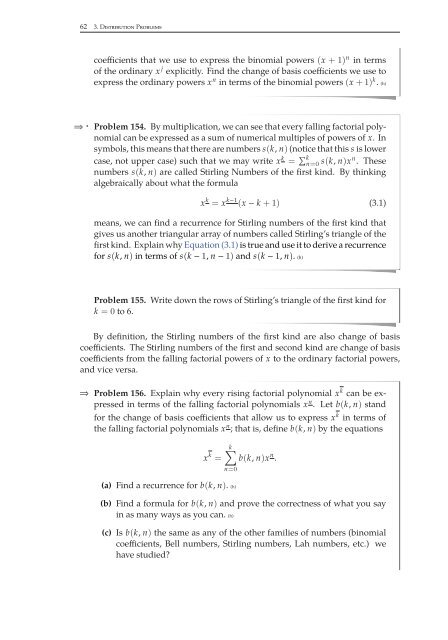Combinatorics Through Guided Discovery, 2004a
Combinatorics Through Guided Discovery, 2004a
Combinatorics Through Guided Discovery, 2004a
You also want an ePaper? Increase the reach of your titles
YUMPU automatically turns print PDFs into web optimized ePapers that Google loves.
62 3. Distribution Problems<br />
coefficients that we use to express the binomial powers (x +1) n in terms<br />
of the ordinary x j explicitly. Find the change of basis coefficients we use to<br />
express the ordinary powers x n in terms of the binomial powers (x +1) k . (h)<br />
⇒ ·<br />
Problem 154. By multiplication, we can see that every falling factorial polynomial<br />
can be expressed as a sum of numerical multiples of powers of x. In<br />
symbols, this means that there are numbers s(k, n) (notice that this s is lower<br />
case, not upper case) such that we may write x k = ∑ k<br />
n=0 s(k, n)x n . These<br />
numbers s(k, n) are called Stirling Numbers of the first kind. By thinking<br />
algebraically about what the formula<br />
x k = x k−1 (x − k +1) (3.1)<br />
means, we can find a recurrence for Stirling numbers of the first kind that<br />
gives us another triangular array of numbers called Stirling’s triangle of the<br />
first kind. Explain why Equation (3.1) is true and use it to derive a recurrence<br />
for s(k, n) in terms of s(k − 1, n − 1) and s(k − 1, n). (h)<br />
Problem 155. Write down the rows of Stirling’s triangle of the first kind for<br />
k =0to 6.<br />
By definition, the Stirling numbers of the first kind are also change of basis<br />
coefficients. The Stirling numbers of the first and second kind are change of basis<br />
coefficients from the falling factorial powers of x to the ordinary factorial powers,<br />
and vice versa.<br />
⇒<br />
Problem 156. Explain why every rising factorial polynomial x k can be expressed<br />
in terms of the falling factorial polynomials x n . Let b(k, n) stand<br />
for the change of basis coefficients that allow us to express x k in terms of<br />
the falling factorial polynomials x n ; that is, define b(k, n) by the equations<br />
x k =<br />
k∑<br />
b(k, n)x n .<br />
n=0<br />
(a) Find a recurrence for b(k, n). (h)<br />
(b) Find a formula for b(k, n) and prove the correctness of what you say<br />
in as many ways as you can. (h)<br />
(c) Is b(k, n) the same as any of the other families of numbers (binomial<br />
coefficients, Bell numbers, Stirling numbers, Lah numbers, etc.) we<br />
have studied?


















